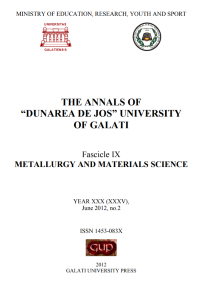Study for Evaluation and Optimization of Mineral Composition and Structure of Iron Ore Granulation in Sintering Process
Abstract
The characterization of iron ore particles is of vital importance for the study of mineral composition. The specific surface area of iron ore particles can be measured by laser diffraction, and mathematical models (based on the size distribution). Particle size fractions and chemical composition were determined of several types of iron ore (symbolically marked A, B, C, D, E, F). These features have direct influence on the sintering process by particle size analysis, permeability, reducibility, porosity, CaO/SiO ratio, influence of MnO in sinter. The granulation experiment show that these minerals (more than 50% with diameters of <1mm) can be successfully used in the sintering process, or by alloying with other minerals in Europe. Large irregularly shaped and adhesive particles can get a higher efficiency of granulation easily. The usage of iron ore with big and rough particles can improve the permeability while the iron ore with smooth and sphere particles has poor ability of granulation.
Downloads
References
[2]. N. J. Bristow and C. E. Loo - ISIJ Int., 32 (1992), 819.
[3]. T. Maeda and Y. Ono - Tetsu-to-Hagané, 77 (1991), 1569.
[4]. Y. H. Yang and N. Standis - ISIJ Int., 31 (1991), 468.
[5]. S. C. Panigrahy, P. Verstraeten and J. Dilewinjns - Metall. Trans. B, 15B (1984), 23.
[6]. Yu. S. Karabasov, A. N. Pokhvishev, E. F. Shkurko and V. S. Valvin - Steel USSR, 5 (1975), 583.
[7]. N. K. Kornilova, E. F. Vegman and S. E. Lazutkin - Steel USSR, 3 (1973), 1.
[8]. T. Hamada, T. Koitabashi and K. Okabe - Tetsu-to-Hagané, 60 (1974), 465.
[9]. H. Toda and K. Kato - Trans. Iron Steel Inst. Jpn., 24 (1984), 178.
[10]. Y. Hosotani, N. Konno, K. Yamaguchi, T. Orimoto and T. Inazumi - ISIJ Int., 36 (1996), 1439.
[11]. N. Matsuo, T. Maeda and Y. Ono - CAMP-ISIJ, 4 (1991), 1081.
[12]. S. Sato, M. Ichidate, K. Kato and T. Kawaguchi - Tetsu-toHagané, 69 (1983), S744.
[13]. D. Jeulin, J. L. Latailleur, A. M. Schneider - Proc. Int. Symp. on Agglomeration (Agg. 77), ed. by K. V. S. Sastry, Amer. Inst.of Mining, Metallurgical & Petroleum Engineers, NY, (1977), 526.
[14]. Ram Pravesh Bhagat, Uday Shankar Chattoraj - ISIJ Int., 46 (2006), 1728.
[15]. Takeshi Maki and Isao Sekiguchi - ISIJ Int., 49 (2009), 631.
[16]. Shinji Kawachi and Shunji Kasama - ISIJ Int., 51 (2011), 1057.
[17]. Xuewei LV, Xiaobo HUANG, Jaqing YIN and Chenguang BAI - ISIJ Int., 51 (2011), 1432.



